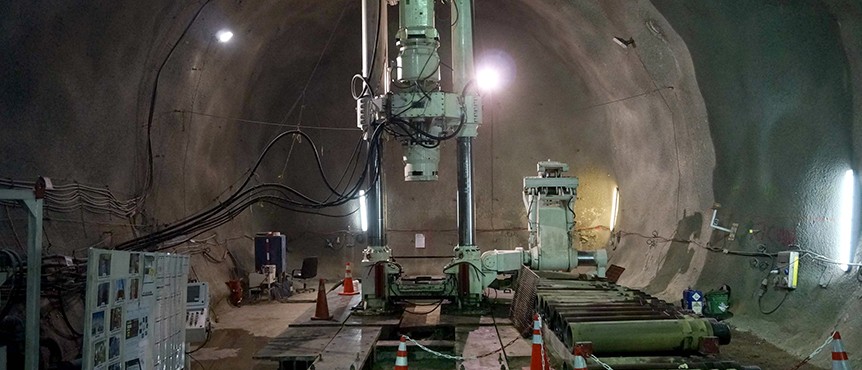Chile is a hotbed for technological development in the quest for efficiencies.
RELATED PUBLICATION
ARTICLES FROM THIS PUBLICATION
Innovation and the Future of Mining in Chile

If a silver lining could be drawn from the downturn in the price of copper, it is that Chile has essentially been forced into becoming a global nucleus for technological innovation and engineering expertise. As mining companies focus on cutting costs while maintaining their levels of production, engineers have been tasked with developing efficiencies and fabricating creative solutions. While this is the case in mining jurisdictions around the world, Chilean mining engineers have a particularly high reputation and are considered on par with those in Canada and Australia. “The Chilean engineer is well recognized around the world in the mining industry,” explained Juan Pablo González Toledo, president of the Institute of Mining Engineers. “In general, the perception of Chilean engineers is very strong in mining and in other industries.”
Chile’s mining expertise and the industry’s call for creating efficiencies have coalesced into a perfect storm of innovation. There is a general consensus around the mining industry that autonomous mining is the most exciting of these innovations due to its positive financial, environmental, and safety implications. “One of the positive things about automation is that it is steady, which reduces variability and saves millions of dollars,” said Felipe Cabrera, general manager of Emerson Automation Solutions. “Automation also greatly reduces the risk of people working in the mines being injured.”
CODELCO’s Gabriela Mistral mine is thus far Chile’s most advanced mine in terms of operating autonomously. While mining companies generally appear to be quite receptive to the idea of automated operations, labor unions are much more skeptical. While it is reasonable to conclude that autonomous mining will replace human workers with machines, it does not necessarily imply fewer jobs available in mining. On the contrary, many believe the new technology will, in fact, elicit new employment opportunities. As Pedro Damjanic, senior vice president of mining at Finning Chile, stated: “Some people are scared that autonomous mining will result in a loss of jobs, but what they forget is that it creates opportunities to open many other mines that are otherwise too expensive to pursue.”
Even if autonomous mining does create new job opportunities, many of the workers who are replaced may not be qualified for these new positions. According to Felipe Cabrera: “The challenge when removing people from risky positions is that, while we would like to place them in front of a control console where they can oversee the operation and come up with ways to optimize production, those positions require a whole different set of skills than what they have.”
Autonomous mining addresses the fact that thousands of workers can be living on a mine site at one time, which is costly in terms of both accommodations and employee morale. Remote operations is an increasing popular technological focal point, as it would allow employees to telecommute to a mine from a control center at the company’s headquarters. ABB, for example, has already developed this technology and uses it to monitor their operations at their clients’ mine sites, as opposed to sending their employees back and forth. According to Jorge Abraham, ABB’s industry lead for mining: “The opportunity to work on mines remotely is going to be the next big demand trend, and that is something ABB is pushing for.”
The use of data has also become more prevalent in the mining industry. Each rock in a mine and each machine part have various data points associated with them, resulting in a nearly incalculable quantity of data at any given mine site. Some equipment companies have begun to leverage Big Data analytics to develop predictive capabilities that limit operational downtime, which could potentially cost a mining company thousands of dollars for every hour a machine is down. “Regular maintenance is important, but it can be costly if parts are replaced or repaired at the wrong time,” said Marcelo Celis, general manager of Bosch Rexroth. “Production downtimes can have a devastating impact, which quickly affects many other parts of the value chain.”
One of the most pressing issues in Chile’s mining industry is water scarcity. While Chile evidently has plenty of access to water on its coast, transporting water to high-altitude mines has proven very costly in terms of the amount of energy it requires. Underground water is also becoming increasingly scarce and energy-consuming to extract, driving both producers and service providers to devise new water recycling tactics. “Kinross has taken measures to be more efficient with water usage and is using less water to produce the same amount of ore,” said Jose Letelier. “We recycle a high percentage of the water we use, we have improved our piping, and we have lowered evaporation rates, which is a common issue at such high altitudes.”
As the state of the mining industry has repeatedly flashed its hazard lights over the past several years, mining companies have no choice but to consider the future. Whether it is a response to companies cutting costs or environmental challenges, Chile and its talented pool of engineers are prepared to lead the charge toward more efficient mining practices as commodity markets are poised to rebound. While producers prepare for the next mining boom, suppliers are positioning themselves to handle the corresponding demand. According to Felipe Azócar, general manager of Tetra Tech Metálica: “Now that the mining economy is slower, companies are taking opportunities to cut costs wherever they can and keep up with the new market conditions.”












